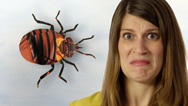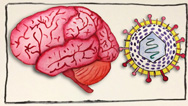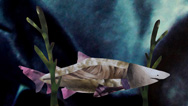What Lives in Cheese?
- Posted 06.11.15
- NOVA
What makes cheese so delicious? It's the bacteria, fungi, mites, and maggots living in it. Learn more in this episode of Gross Science.
Transcript
What Lives In Cheese?
Posted: June 11, 2015
What makes cheese so delicious? It’s the bacteria, fungi, and mites living on it, of course!
I’m Anna Rothschild, and this is Gross Science.
Cheeses come in many different forms. They can be soft, hard, mild, stinky, you name it. But if you look at the label, most cheeses are made of the same handful of ingredients. There’s milk, salt, a slurry of enzymes called “rennet,” and… bacteria.
At it’s most basic, cheese is really just curdled milk with some of the liquid removed. Mixing in bacteria allows the curds to ferment, and different strains of bacteria can create a diversity of flavors and textures. For example, swiss cheese is made using a strain of bacteria that releases carbon dioxide during fermentation. The CO2 gets trapped, causing those characteristic holes to form. And the odor of smelly feet emanating from limburger cheese comes from a strain that’s closely related to one living on human feet—thus the similar smell.
Cheese makers can create other varieties by adding fungus to the mix. For example, bleu cheese wouldn’t even be blue without the spores of Penicillium roqueforti. In fact, cheese makers poke holes in bleu cheese to allow the fungus can breath and grow.
The outsides of cheeses are crawling with even more life. Cheese rinds are essentially biofilms. They’re communities of microorganisms, and include strains of bacteria and fungi from the environment that are attracted to the cheese as it ages. In fact, there are whole labs at places like Harvard that are studying how these funky communities form and interact.
And that’s not all. Cheeses can also be covered in mites, which eat the fungal tendrils in cheese rinds. On some varieties they’re seen as a pest, but on others, like mimolette, they’re specifically added to give the cheese a particular flavor.
To top it off, on the island of Sardinia, there’s a delicacy called casu marzu, which literally means “rotten cheese.” Before it’s eaten by humans it’s feasted on by the larvae of the cheese fly, which makes it very soft and pungent. Many diners actually eat the delicacy live-maggots and all.
This all might sound super nasty, but so many of our favorite foods are created in similar ways. Bread, wine, yogurt, pickles—they’re all made by letting other organisms, like yeast and bacteria, digest parts of our food before we do. And frankly, if it means I get to keep eating parmesan on my pasta, I’m happy to embrace the creepy crawlies living in it.
Ew.
Credits
PRODUCTION CREDITS:
- Host, Writer, Animator, Editor
- Anna Rothschild
- DP, Sound, Intern Extraordinaire
- Kristen Clark
- Many thanks to Dr. Benjamin Wolfe and Andrew Janjigian.
- Musette Parisienne
- Music Provided by APM
IMAGES
- Images of cheese microbes and video of cheese mite
- Courtesy Benjamin Wolfe
- 105° + rennet = Miss Muffet’s Fantasy
- Flickr/Baron Chandler
- Curds and whey
- Flickr/Cecilia
- Delicious Cheese
- Flickr/Chris Buecheler
- iPhone Background – Cheese Please
- Flickr/Patrick Hoesly
- NCI swiss cheese
- Wikimedia Commons/National Cancer Institute
- Limburger-Käse
- Wikimedia Commons/MarkusHagenlocher
- Roquefort Coulet
- Flickr/Sarah Nichols
- Coulommiers lait cru
- Wikimedia Commons/Myrabella
- Mimolette3
- Wikimedia Commons/Chris Waits
- Casu Marzu cheese
- Wikimedia Commons/Shardan
SFX
- Cockroaches
- Freesound/StateAardvark
(used with permission from author) - Squeak Pack/squeak_10
- Freesound/Corsica_S
- Bubbling Popping
- Freesound/Ch0cchi
- Sniff
- Freesound/jrssandoval
- Produced by WGBH for PBS Digital Studios
IMAGE
- (main image: Cheese and Bacteria)
- ©WGBH Educational Foundation 2015
Sources
Want more info?
The Wolfe Lab at Tufts University
https://sites.tufts.edu/wolfelab/
The Dutton Lab (note: this lab is moving from Harvard to UCSD):
https://sites.google.com/site/theduttonlab/
Gordon Ramsay’s F Word on casu marzu:
https://www.youtube.com/watch?v=vZ_-JzM-YQg
Related Links
-

Gross Science
Bizarre stories from the slimy, smelly, creepy world of science.
-

The Mites That Live On Your Face
There are tiny mites eating, laying eggs, dying, and leaking feces on your face.
-

Herpes and the Brain
Herpes is probably hiding in your nerve cells right now.
-

When Shark Fetuses Attack
Sand tiger shark fetuses eat their siblings in the womb.

